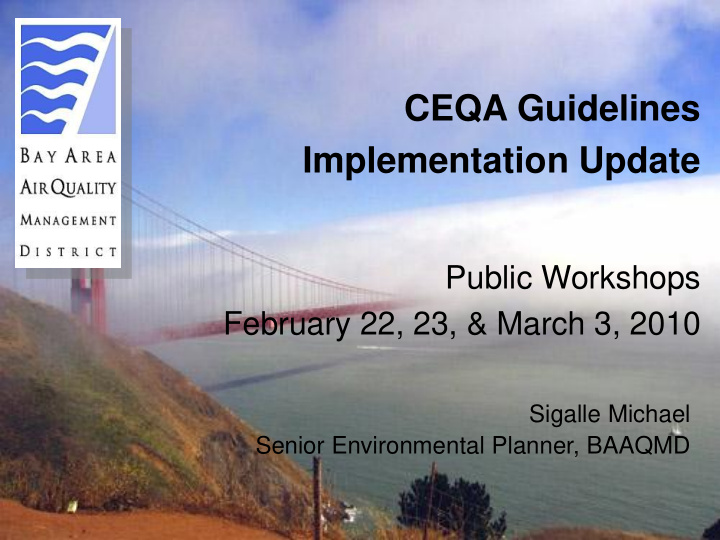



CEQA Guidelines Implementation Update Public Workshops February 22, 23, & March 3, 2010 Sigalle Michael Senior Environmental Planner, BAAQMD
Agenda Update on Risk & Hazard threshold Update on GHG threshold Regional Agency Collaboration Questions 2
Since June 2010 CEQA thresholds adopted in June 2010 Local governments are applying thresholds Continuing to enhance and provide resources and tools for applying thresholds Working with local planners and stakeholders to address questions and issues 3
Risk & Hazard Update May 1, 2011 set as effective date for risk & hazards threshold for new receptors Roadway and stationary source screening tables updated since June 2010 Further refinement with local data in progress Construction Risk Calculator under development 4
Risk & Hazard Screening Process New flow-chart outlines steps to risk & hazard screening analysis process Describes conservative nature of screening tables Outlines guidance on refining impact analysis from sources and roadways District staff providing technical assistance as needed 5
Addressing Issues Heard to Date Screening tables are overly conservative Risk & hazard process could deter infill/affordable housing Challenging for construction projects to meet threshold Consider best management practices for construction emissions Need more useful construction screening process Need quantified mitigation measures to reduce impacts 6
Integrating Risk & Hazards with Local Planning Community Risk Reduction Plan Pilot projects underway in San Jose and SF $50,000 to SJ and SF to support local staff District assisting with workplan, emissions inventories, modeling, outreach Addressing challenges in identifying geographic boundaries, risk reduction targets, mitigation measures Other cities committing to develop CRRP – Santa Clara, San Pablo, Walnut Creek Community Development Guidelines Simplify process for analyzing risk & hazard impacts Standardize setbacks and mitigation measures for sources Draft anticipated for July 2011 7
Risk Reduction Strategies Examples of risk reduction strategies being reviewed and quantified: Indoor air quality filters and ventilation Building heights and air intakes Tree and vegetation buffers Construction equipment technologies Truck routes and idling limitations Railroad and harbor craft technologies Source specific setbacks for drycleaners, back-up generators, gas stations, etc. Land use and transportation planning to reduce vehicle emissions 8
Questions Are you using the risk & hazard screening tools? Ideas for risk reduction strategies we should study? Requests for other specific tools, resources, or trainings? Other cities interested in developing a CRRP? Other questions/comments? 9
GHG Update CAPCOA GHG Quantification Report released Transportation Demand Measures Model – supports VMT reductions for TOD/infill projects URBEMIS/BGM classroom and online training videos New GHG case stories from local governments on District’s climate portal: www.baaqmd.gov/climateplanning 10
Addressing Issues Heard to Date Need GHG threshold for construction How to address projects or emissions that do not fit into CEQA Guidelines methodology, such as landfill emissions Need guidance on how to account for reductions from state measures for 2020 and beyond Need more consistent methodology for quantifying transportation GHG emissions How will future projects demonstrate consistency and tier off GHG Reduction Plan 11
Collaborating with Local Governments Reviewing GHG Reduction Strategies - Solano County, Napa County, San Francisco, Dublin, East Palo Alto, San Ramon Local governments are committing to developing GHG Reduction Strategies- Redwood City, City of Santa Clara, San Pablo, Walnut Creek Working with local planners on innovative approaches to address GHG GHG performance measures for datacenters GHG threshold for land conversions 12
CEQA Project Review Comment letters support good projects and project features Solano County Climate Action Plan – reduction targets beyond AB 32, strong mix of mandatory and voluntary measures Redwood City Downtown Precise Plan – TOD, innovative parking strategies, bicycle & pedestrian infrastructure San Francisco GHG Reduction Strategy – already meeting GHG reduction targets beyond AB32, meets District’s qualifying criteria City of Santa Clara General Plan – focus on infill/TOD development, commitment to 13 prepare climate action plan and CRRP
GHG Reduction Strategies Improved features: Targets are compatible with AB32 Measures are being quantified Implementation plans include regular updates Environmental review is being done Integration with general plans Common issues: Leaving emission sources out of inventories (direct access, industrial emissions and water/wastewater treatment are common omissions) Data sources and assumptions are often not transparent and clarifications are needed Too big a reliance on voluntary measures to achieve targets – need more mandatory measures Existing development not addressed aggressively enough 14
Questions Share experience in developing climate action plan? Share innovative mitigation measures? Are projects implementing off-site mitigation? Would a District off-site mitigation program be useful? Other questions/comments? 15
Regional Agency Collaboration Coordinating with MTC, ABAG, and BCDC Convened Air Quality/PDA workgroup Conducting risk and hazard analysis for PDA communities Support plan level efforts to address air quality impacts and CEQA Streamline CEQA review for PDAs Complement SB 375 process Model to calculate benefits of transportation measures in PDAs Participating in regional Bay Area Planning Directors Association (BAPDA) meetings 16
SB 375 Coordination Provide technical expertise in regional modeling and housing methodology efforts Support streamlining CEQA through SCS Continue to monitor SB 375 and state regulations Will update CEQA Guidelines to complement SB 375 and SCS 17
Questions Share any specific air quality challenges in PDA communities? Have you seen only air quality trigger a DEIR? Other questions/comments? 18
Recommend
More recommend